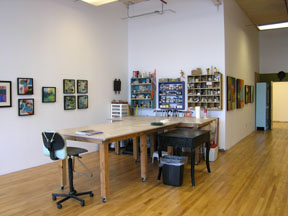While in New York in December, my art pal
Binnie and I visited the
Michael Rosenfeld Gallery to see Betye Saar's show "Cage," a new series of assemblages and collages that were contained in or referenced vintage cages. The cages referred directly to the imprisonment and ocean transport of African slaves. Saar is, of course, known for her political transformation of demeaning images of Black people. She has also explored gender, spirituality and family histories in her work. One of the notable facets of her life, aside from or perhaps directly related to her own art making, is that she and her husband (an art conservator and ceramist) raised three daughters - two artists and a writer - who carry on their family tradition of creative work.
 |
| A work in the "Cage" exhibition |
Note: I was able to locate images of Saar's work from an article in Curated Magazine by Michael Rosenfeld Gallery, but the article has no information on titles, sizes or materials.
Saar herself is of mixed race and has said the following about her use of racial motifs or provocative images:
"I think that was my way of responding to what was happening in the United States and the treatment of the blacks in the South and also a reaction to the death of Martin Luther King. I had previously started to collect derogatory black images, and I recycled them into my work to express rage or pain or just how I felt about this country politically." (quoted in
Betye Saar: Extending the Frozen Moment)
Saar, a native Californian, is currently a vibrant 84 year old and lived through the civil rights movement. She began using racial images in the late 1960s after witnessing the 1965 race riots in Watts, the assassination of Dr. King in 1968 and the 1960s emerging women's and black arts movemenst. By the early 1970s, she had produced more than 20 pieces of politically and racially powerful works, including what is probably her best known work,
The Liberation of Aunt Jemima.
 |
| The Liberation of Aunt Jemima, 1972, mixed media assemblage, 11 3/4" x 8" x 2 3/4". |
About this work, Saar has said, "My intent was to transform a negative, demeaning figure into a positive, empowered woman..., a warrior ready to combat servitude and racism."
Perhaps we (and by "we" I mean especially white people) in the United States thought that racial stereotyping and demeaning images were far behind us, but with the campaign and election of President Obama, we have learned, to what must be our shame and regret, that the images and the racial discrimination behind them are still very much present in our society. These images are part of our history and Saar wants us to remember them, not in terms of their victimization of a race, but "to reveal the human complexity which stereotypes are intended to conceal." (Ralph Ellison, introduction to
Invisible Man, 1981.)
 |
| Betye Saar, 2006, with three of her works. |
Saar has used photographs extensively in her work, discussed at length in
Betye Saar: Extending the Frozen Moment. She is inspired by photographs that she finds at swap meets, garage sales, thrift shops and antique fairs, to create a context for the people pictured that allows her imagination and wonderful eye to combine objects and finds from many sources into her unique assemblages. These new artworks present "counter-images of African American life--images of dignity, pride, success and beauty." (Deborah Willis and Carla Williams,
The Black Female Body: A Photographic History, 2002). Saar also aims to capture what feels like history but is not located in a specific time or place.
 |
| Midnight Madonna, 1996, mixed-media assemblage, 14" x 11" x 1 l/2" |
 |
| Birds of a Feather, 2010. Mixed media collage on paperboard 12 3/4″ x 12″ |
Betye Saar is a master of assemblage who has brought together some amazing objects and composed them into a new life. I greatly respect her transformative work with the racial images and her evocative use of found photographs. However, many of her boxes relate to those of Joseph Cornell, and like his work, I feel that they sometimes fail to achieve a certain beefy materiality that appeals to me. That is, I think they honor the found object too much to the detriment of the composition; they fail to manipulate the objects enough to make them lose their individual identity.
For my sensibility, Betye Saar's daughters, Lezley and Alison Saar, have taken their mother's work and really carried it forward. While many of their works also reference race and identity, they have a different take on it than their mother. But see what you think...
 |
| Lezley Saar - I think this is "Identify Crisis" |
 |
| Lezley Saar - "Saint Anastacia," a blue-eyed, biracial saint revered in Brazil |
 |
| Alison Saar, "Blood/Sweat/Tears," 2005, wood, copper, bronze, paint and tar, 72"x24"x20" |
 |
| Alison Saar, "Discord," 2009, wool, steel, fiberglass, coal and styrofoam, 104"x40"x40" |
 |
| Alison Saar - Harriet Tubman statue entitled "Swing Low", front view, public installation in Harlem |
xx





















